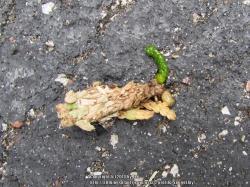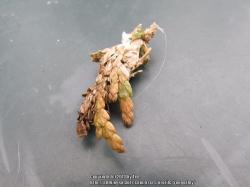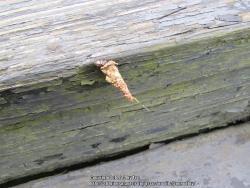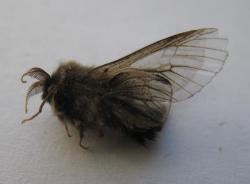In my area, one of the most serious bagworm moths is Thyridopteryx ephemeraeformis, the Evergreen Bagworm Moth. The moth thrives in the eastern United States, New England, and west as far as Nebraska. It is found south to the Gulf of Mexico and throughout Texas. With few predators in urban areas, the Evergreen Bagworm Moth often thrives in those habitats as well. In heavily forested areas, large populations are rare.
Arborvitae and red cedar are the favored host plants for the Evergreen Bagworm Moth. Cypress, spruce, juniper, pine, apple, birch, black locust, elm, maple, poplar, oak, sycamore, willow, and over 100 other species are also attacked. Both leaves and buds are subject to attack.
It is often easy to hand-pick bagworms when shrubs and trees are small. As the host plant grows larger, it frequently becomes impossible to hand-pick the worms and some type of insecticide is usually needed to stop infestations. When disturbed, a bagworm larva will retract into its case and hold the opening closed, thus making insecticidal sprays relatively ineffective. The best type of control for bagworms on trees and shrubs is a systemic insecticide. Systemics are applied to the ground around the plants and taken up by the roots. When the larvae then eat from the plant, they ingest the insecticide and die. Extension agents and other authorities frequently change the recommendations for the type of insecticide to be used against bagworms in order to help prevent the moths from developing immunity to a particular insecticide. Entomopathogenic bacteria, in particular Bacillus thuringiensis var. kurstaki, offer an effective natural control when applied to early instar bagworm larvae.
Bagworms are parasitized by ichneumonid parasitoid wasps, especially Itoplectis conquisitor. Predators include vespid wasps and hornets. Woodpeckers, sapsuckers, sparrows and mice will feed on the larva.



 It's easy to hand pick and destroy bagworms when the host plant is small.
It's easy to hand pick and destroy bagworms when the host plant is small.  The bagworm eventually produces a strong silk cord and attaches firmly to branches.
The bagworm eventually produces a strong silk cord and attaches firmly to branches.
 Bagworm on the move
Bagworm on the move Thyridopteryx ephemeraeformis, the Evergreen Bagworm Moth
Thyridopteryx ephemeraeformis, the Evergreen Bagworm Moth Itoplectis conquisitor, a natural predator of the bagworm
Itoplectis conquisitor, a natural predator of the bagworm| Thread Title | Last Reply | Replies |
|---|---|---|
| I hate those things LOL by TexasPlumeria87 | Jul 6, 2014 11:45 AM | 2 |
| Evil!! by stilldew | Jul 6, 2014 6:36 AM | 1 |
| Know a fisher-person? Free Bait--You Pick! by Wes | Jul 6, 2014 3:47 AM | 1 |
| Very informative, thanks. by greene | Jul 6, 2014 3:44 AM | 1 |